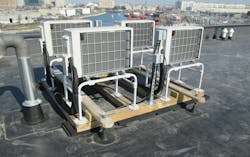The Distillery North Apartments, located in South Boston, is a 28-unit complex that follows the Passive House model, a building standard aimed at true energy efficiency, comfort and affordability. With strict energy standards, the complex required a highly-efficient HVAC system.
In 1984, Fred Gordon, principal owner of Second Street Associates, LLC, Boston, bought an old, 100,000 square-foot rum distillery originally owned and operated by Felton Rum. Five generations of the Felton Family made distilled rum in New England for 150 years.
“I just fell in love with it,” said Gordon of the warehouse. “It was a building that nobody wanted, in a part of the city that nobody wanted to be in and I, in certain ways, predicted that the whole thing would turn around.”
Fast-forward to the mid-1990s, Gordon was determined to use the space to contribute to the environmental movement. He bought the rest of the city block and in 2009 decided to build a multifamily Passive House on the distillery property.
Targeting energy reductions of at least 60 percent, Gordon and his team had to tackle two issues to attain Passive House status: cut energy loads down as much as possible and use green power to assist in covering those loads. The Passive House Standard has strict benchmarks surrounding cooling and heating, requiring the building to have controlled mechanical ventilation with heat recovery (MVHR). After 100 photovoltaic solar panels were selected to help bring in green energy, Gordon knew a highly-efficient HVAC system with air-source heat pumps and heat exchangers that could perform MVHR functions was needed.
The Distillery North Apartments have been open for tenancy since April 2017. Gordon and his wife, who actually live in the building, have been quite pleased with the energy performance. Between the solar panels, positioning of the complex and an energy-efficient HVAC system, Gordon and his colleagues at Second Street Associates believe the utility savings are a real perk for residents.
“For heating and cooling, we’re talking $65 per unit, per year - that’s less than a cappuccino from Starbucks,” said Gordon.

